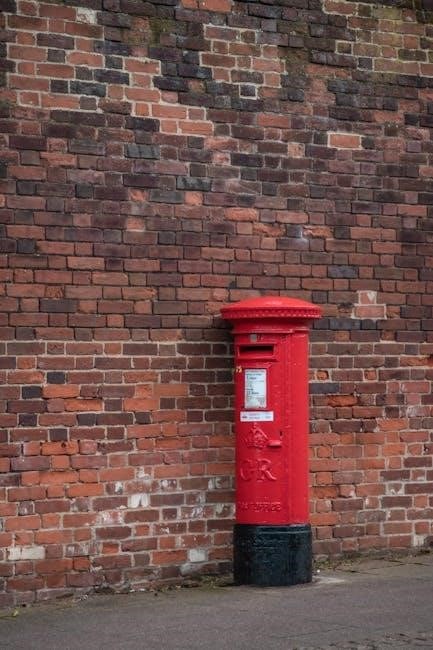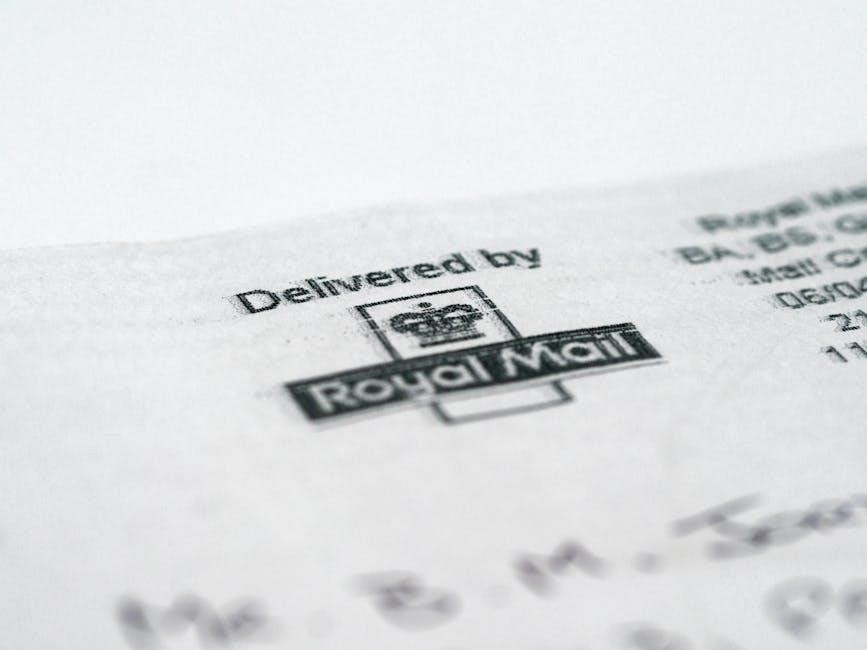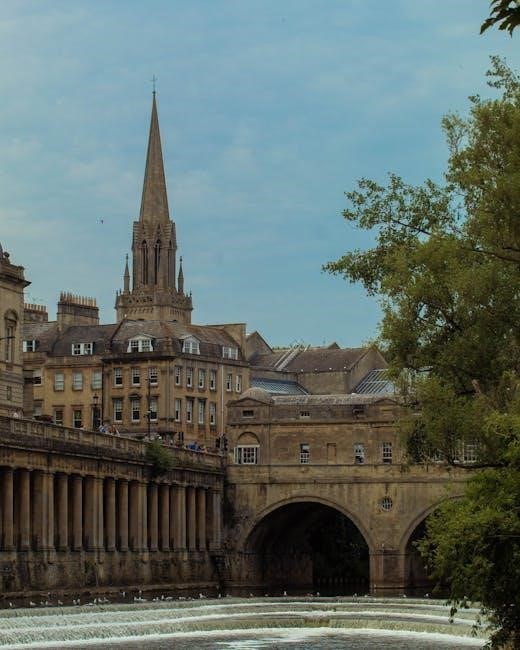A UK visit visa cover letter is a formal document accompanying your application, detailing your travel plans, purpose of visit, and financial arrangements. It helps visa officers understand your intent and supports your application by providing additional context, increasing the chances of approval.
1.1 Importance of a Cover Letter in Visa Applications
A cover letter is a crucial document in UK visa applications, serving as a personal introduction and explanation of your visit. It bridges the gap between the visa application form and your unique circumstances, allowing you to provide context and clarity; Visa officers review numerous applications, and a well-crafted cover letter can make your case stand out. It highlights your genuine intent to comply with visa terms, demonstrating your credibility and commitment to returning home. A compelling cover letter can significantly enhance the likelihood of a successful application, making it an essential step in the process.
1.2 Overview of UK Visit Visa Requirements
Applying for a UK visit visa requires meeting specific criteria to demonstrate eligibility. Key requirements include proof of financial stability, confirmed travel plans, and accommodation details. Applicants must show intent to return home after their visit, supported by strong ties such as employment, family, or property. A clear purpose of visit, whether for tourism, business, or visiting family, must be stated. Submission of a cover letter is highly recommended to provide context and clarity to the application. Meeting these requirements thoroughly increases the likelihood of a successful visa outcome.

Key Components of a UK Visit Visa Cover Letter
A UK visit visa cover letter must include personal details, purpose of visit, travel plans, accommodation, financial proof, intent to return, and contact information.
2.1 Personal Details
Your cover letter should begin with your full name, current address, contact number, and email address. Ensure the letter is dated and all details are accurate. Including your passport number is optional but can help in processing. Clearly state your name as it appears on your passport to avoid discrepancies. Providing correct contact information is crucial for communication. Double-check all personal details for accuracy to maintain professionalism and avoid delays. This section sets the tone for the rest of the letter, demonstrating your attention to detail and seriousness about the application.
2.2 Purpose of Visit
Clearly state the reason for your visit, such as tourism, business, or visiting family. Be specific about your plans, like sightseeing, meetings, or attending events. Mention the duration of your stay and how it aligns with your purpose. For tourism, express your interest in UK landmarks or cultural experiences. For business, include meeting details or conference participation. For family visits, specify the relationship and duration of stay. Avoid vague statements and ensure your purpose aligns with UK visa guidelines. This section demonstrates your intent and helps officers assess your application’s validity, increasing the likelihood of approval.
2.3 Travel Plans and Itinerary
Provide a detailed breakdown of your travel plans, including entry and exit dates, cities to visit, and key activities. Outline your flight details, accommodation bookings, and any pre-arranged tours or appointments. Clearly explain how your itinerary aligns with the purpose of your visit. For example, if visiting family, specify the duration of stay with them. If touring, list key attractions or cities you plan to explore. Ensure your travel plans are realistic and well-structured, demonstrating a clear and organized trip. This section helps visa officers confirm the legitimacy of your plans and assess your application more effectively.
2.4 Accommodation Arrangements
Clearly outline your accommodation plans in the UK, specifying where and with whom you will stay. Provide details such as hotel bookings, hostel reservations, or a letter of invitation if staying with family or friends. Include the full address, contact details, and dates of stay. Attach supporting documents like booking confirmations or rental agreements. If staying with a host, mention their relationship to you and ensure they are aware of your visit. This section demonstrates your preparedness and ensures visa officers can verify the legitimacy of your stay in the UK.
2.5 Financial Documentation
Provide detailed financial documentation to demonstrate your ability to cover trip expenses. Include bank statements showing sufficient funds, employment letters confirming income, and payslips. Attach property deeds or rental agreements if applicable. Clearly state the total amount available for the trip and outline estimated expenses for travel, accommodation, and daily costs. Ensure all documents are recent and translated if necessary. This section proves your financial stability and ability to support yourself during your stay in the UK, addressing concerns about public funds reliance or overstay.
2.6 Intent to Return Home
Clearly stating your intent to return home after your visit is crucial. Explain your strong ties to your home country, such as employment, family, property, or ongoing commitments. Mention your job role, salary, and leave approval, if applicable. Highlight ownership of assets like property or businesses. Emphasize family responsibilities, such as dependents or elderly care. Provide evidence of future plans, like a return-to-work letter or enrollment in education. Demonstrating these ties reassures visa officers of your intention to return, aligning with visa requirements and improving approval chances.
2.7 Contact Information
Including your contact information ensures visa officers can reach you if needed. Provide your full name, current address, phone number, and email address. Ensure all details are accurate and up-to-date. Clearly format this section for readability. For example, list your name, address, phone number, and email in separate lines. Double-check for typos to avoid communication issues. This demonstrates professionalism and makes it easier for authorities to contact you regarding your application. Accurate contact details are essential for a smooth visa process and show your reliability as an applicant.

Sample UK Visit Visa Cover Letter PDF
A sample cover letter PDF provides a template for UK visit visa applications, outlining the purpose of visit, travel plans, financial arrangements, and intent to return home.
3.1 Structure of the Sample Cover Letter
The sample cover letter typically begins with personal details, including name, address, and contact information. It then states the purpose of the visit, such as tourism, business, or visiting family. Next, it outlines travel plans, including dates and destinations, followed by accommodation arrangements. Financial documentation, like bank statements, is mentioned to demonstrate sufficient funds. The letter also emphasizes the intent to return home, highlighting ties to the home country. Finally, it closes with a polite request for approval and provides contact details for further inquiries.
3.2 How to Use the Sample PDF
Download the sample PDF and use it as a template for your cover letter. Replace placeholders with your personal details, travel dates, and purpose of visit. Customize the content to match your specific situation, ensuring all required sections are filled. Attach supporting documents like flight bookings, accommodation proofs, and financial statements. Review the letter for clarity and accuracy before submission. Tailor the sample to your visa type, whether for tourism, business, or family visits, ensuring it aligns with your application’s purpose.

Writing a Compelling Cover Letter
A compelling cover letter for a UK visit visa should clearly outline your travel plans, purpose, and financial stability. Use concise language and ensure all details align with your application to convince the visa officer of your genuine intent to visit and return home.
4.1 Understanding the Visa Officer’s Perspective
Understanding the visa officer’s perspective is crucial when drafting your cover letter. Officers assess applications to ensure compliance with visa rules and verify the applicant’s genuine intent to visit and return home. They prioritize clear, concise information that aligns with the stated purpose of the visit. Highlighting strong ties to your home country, such as family, employment, or property, demonstrates intent to return. Ensuring your letter addresses these concerns directly increases the likelihood of a positive outcome. A well-structured and honest approach fosters trust and supports a successful application.
4.2 Language and Tone Guidelines
The language and tone of your cover letter should be formal, clear, and concise. Avoid using slang, jargon, or overly complex sentences, as this may confuse the visa officer. Use polite and professional language throughout, ensuring your intent is communicated clearly. Be specific about your purpose of visit, travel plans, and accommodation arrangements. Maintain a respectful tone, as this reflects your sincerity. Avoid exaggeration and ensure all information is accurate. The goal is to present your case in a straightforward and honest manner, fostering trust with the visa officer and supporting your application effectively.
4.3 Key Phrases to Include
Include clear and concise phrases that outline your intent, such as, “I am writing to apply for a UK visit visa” or “My purpose of visit is tourism/business/family visit.” Specify your travel dates, e.g., “I intend to visit from [start date] to [end date].” Mention your accommodation arrangements, like “I will stay with my relative/friend at [address]” or “I have booked a hotel.” Highlight your intent to return home by stating, “I will return to my home country on [date]” and mention ties such as family, job, or property. Always include a polite closing, e.g., “Thank you for considering my application.”

Tips for a Successful Cover Letter
Be concise, clear, and use simple language. Avoid jargon and ensure your letter is well-structured. Highlight strong ties to your home country to demonstrate intent to return.
5.1 Be Concise and Clear
Ensure your cover letter is concise and free from unnecessary details. Stick to the purpose of your visit, travel plans, and financial arrangements. Avoid lengthy paragraphs and use clear, straightforward language. This helps visa officers quickly understand your application. Keep sentences short and avoid jargon. Ensure all information is relevant and directly supports your visa application. Clarity is key to making a positive impression and demonstrating your intent to comply with visa requirements. A well-structured, concise letter reflects professionalism and seriousness about your trip.
5.2 Avoid Jargon and Complex Sentences
Use simple and clear language in your cover letter to ensure visa officers can easily understand your application. Avoid jargon or overly complex sentences, as they may confuse the reader. Your goal is to communicate your intentions clearly and concisely. Simple language demonstrates professionalism and respect for the reader’s time. Additionally, it reduces the risk of misunderstandings that could negatively impact your application. Keep your sentences straightforward and your tone formal yet accessible. This approach ensures your cover letter is both effective and easy to process.
5.3 Highlight Strong Ties to Home Country
Emphasizing strong ties to your home country is crucial in a UK visit visa cover letter. Clearly state your reasons for returning, such as employment, family commitments, or ongoing education. Mentioning ownership of property, business interests, or dependents can demonstrate strong connections. Be specific about your job role, salary, and how your absence is approved. Highlighting these factors reassures visa officers of your intent to return, reducing concerns about overstay. Keep the explanation concise and factual to avoid misinterpretation. This section strengthens your application by showcasing your commitments and responsibilities in your home country.

Common Mistakes to Avoid
Avoid mistakes like incomplete information, vague purpose of visit, or insufficient financial proof. Ensure clarity, proper formatting, and language accuracy to prevent rejection and delays in processing.
6.1 Incomplete or Missing Information
One of the most common mistakes in UK visit visa cover letters is incomplete or missing information. Visa officers rely on the details provided to assess eligibility, so omitting key data like travel dates, accommodation details, or financial proof can lead to delays or rejection. Ensure all required sections are filled out accurately, including personal details, purpose of visit, and contact information. Double-check that all supporting documents are mentioned and attached. Incomplete applications often result in additional requests for evidence, slowing down the process. Attention to detail is crucial to avoid this pitfall.

6.2 Lack of Clarity in Purpose of Visit
A lack of clarity regarding the purpose of your visit is a common issue that can hinder visa approval. Visa officers need a clear understanding of why you intend to visit the UK. Ambiguous statements, such as “personal reasons” or “tourism,” without further details, may raise concerns. Be specific about your plans, such as stating whether you plan to visit family, explore tourist attractions, or attend a business meeting. Failure to provide a clear purpose can lead to rejection or additional questioning. Ensure your cover letter explicitly outlines your intentions and aligns with the visa type you are applying for.
6.3 Insufficient Financial Proof
Insufficient financial proof is a frequent issue in UK visa applications. Applicants often fail to provide adequate documentation, such as bank statements or income proof, to demonstrate their ability to cover trip expenses. Without clear evidence of financial stability, visa officers may question your ability to support yourself during your stay. Ensure your cover letter references attached financial documents, like bank statements or sponsorship letters, and clearly states how these funds will be used for accommodation, travel, and living costs. Vague references to financial resources can lead to rejection, so specificity is crucial to avoid this common mistake.

Cover Letters for Different Types of UK Visas
Cover letters vary depending on the visa type, such as tourist, business, or family visit. Each requires tailored details to align with the visa’s specific purpose and requirements.
7.1 Tourist Visa Cover Letter
A tourist visa cover letter outlines the purpose of your visit, travel dates, and planned activities in the UK. It should include details of your itinerary, accommodation arrangements, and financial proof to demonstrate your ability to support yourself during the trip. Additionally, it should emphasize your intent to return home after your visit. The letter should be concise, clear, and provide a honest overview of your travel plans, helping visa officers assess your application effectively and increase your chances of approval.
7.2 Business Visit Visa Cover Letter
A business visit visa cover letter must clearly state the purpose of your trip, such as meetings, conferences, or negotiations. It should outline your itinerary, including details of appointments and the companies you plan to visit. Additionally, include proof of your employment, your role in the company, and the nature of your business activities in the UK. Mention accommodation arrangements and travel plans, as well as financial proof to demonstrate your ability to cover expenses. The letter should also emphasize your intent to return home after completing your business activities, ensuring compliance with visa regulations.
7.3 Family Visit Visa Cover Letter

A family visit visa cover letter should explain the purpose of the visit, such as meeting relatives or attending family events. It should include details about the family member you are visiting, their UK address, and your relationship. Provide a clear itinerary, accommodation plans, and financial documentation to support your stay. Emphasize your intent to return home, highlighting strong ties to your home country. Mention any previous compliant UK visits to demonstrate reliability. The tone should be sincere and concise, ensuring all information aligns with the visa requirements and supports your application effectively.

Real-Life Examples and Case Studies
Real-life examples highlight successful visa applications, showcasing well-structured cover letters and adherence to guidelines. Case studies reveal common pitfalls, such as incomplete documentation or unclear purposes, to avoid.
8.1 Successful Cover Letter Example
A successful cover letter for a UK visit visa application is clear, concise, and well-structured. For instance, John Doe applied for a tourist visa, detailing his travel dates, accommodation plans, and financial proof. He emphasized his intent to return home by highlighting his job and family ties. The letter was professional, free of jargon, and followed a logical flow, making it easy for the visa officer to understand his intentions. This approach increased his chances of approval and demonstrated a genuine purpose for his visit.
8.2 Lessons from Rejected Applications
Rejected UK visit visa applications often highlight common pitfalls to avoid. Many rejections occur due to incomplete or inconsistent information, such as missing travel details or unclear purposes of visit. Applicants must ensure all documents align with the cover letter. Additionally, insufficient financial proof or lack of clear intent to return home can lead to rejection. Visa officers value clarity and transparency. Learning from these mistakes helps refine future applications, ensuring they meet the necessary criteria and demonstrate genuine intent, thereby improving approval chances. Addressing these issues is crucial for a successful submission.
A well-crafted cover letter is crucial for a successful UK visit visa application. It boosts approval chances by clearly presenting travel plans, financial proof, and intent to return home.
9.1 Final Checklist for Submitting Your Cover Letter
Ensure your cover letter includes personal details, purpose of visit, travel plans, accommodation, financial proof, and intent to return. Verify clarity, avoid jargon, and proofread for errors. Confirm all contact information is accurate and up-to-date. Attach required documents like flight bookings, hotel reservations, and bank statements. Double-check the letter aligns with your visa type (tourist, business, or family visit). Make sure it is concise, well-structured, and free from grammatical mistakes. Finally, review the letter to ensure it reflects your genuine intent and strong ties to your home country.
9.2 Importance of Proofreading
Proofreading your cover letter is essential to ensure clarity and professionalism. Errors in spelling, grammar, or punctuation can create a negative impression and potentially lead to application rejection. Review your letter multiple times, checking for consistency in dates, names, and details. Ensure the tone remains formal and polite. Consider having a trusted individual or professional review it to catch overlooked mistakes. A well-proofread letter demonstrates attention to detail and sincerity, enhancing your credibility and improving your chances of a successful visa application.
